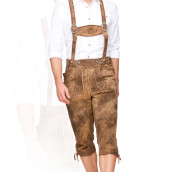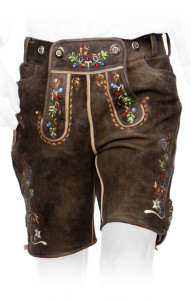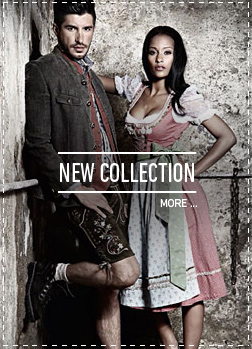Posted by trachten in Dirndl and Lederhosen | Comments Off on The Anatomy of Lederhosen
The Anatomy of Lederhosen

Non-Bavarians who buy leather breeches should be prepared to be mistaken by Bavarians for one of their own and spoken to about their fashion choices – in German or, to put it more precisely, in Bavarian dialect. To make sure that you don’t immediately disqualify yourself from conversation and make a bad impression, here’s a quick vocab course to help you recognise which bits of your lederhosen are being commented on.
Ledahosn
The most important word is, of course, Ledahosn. In standard German, leather trousers are referred to as Lederhosen, but traditional Bavarian breeches are called Ledahosn by those who wear them. The pronunciation is rougher, and the A should really be stressed. Other important words to know are Wildleder and Hirschleder, which is the difference between buckskin and deerskin.
Some anatomical features of lederhosen have their own dialect words, too. The vertical stitch down the back of a pair of short leather breeches is called the Arschnaht: I think that the provenance of this name should, considering the position of this stitch down the backside, be relatively clear. On knee-length lederhosen, you’ll notice a circular stitch around the seat of the trousers: this is called the Tellernaht, or “plate stitch” and allows for this piece of fabric to be exchanged more easily, thus prolonging the life of the lederhosen.
Changing sides on the piece, the oversize flap at the front of lederhosen is referred to as the Hosntürl, or the “little door” to the trousers. Some wags like to call it the “serving plate” – Servierbrettl – and once again, we’ll leave you to cogitate on the connotations of this particular piece of Bavarian slang. Others refer to it as the codpiece (Schamkapsel) in a reference to an element of the predecessor of modern Lederhosen, breeches.
Gschirr
The German word Geschirr generally refers to crockery such as plates and cups, but it can also refer to the saddle and reins for a horse. Since the braces (suspenders) on a lederhosen are made of leather, it’s not hard to see the connection and to work out why they are called Gschirr in Bavarian dialect. Whether they’re “Y form” or “H form” – i.e. with a panel of leather connecting to the two braces at chest height – they are a real and important part of the lederhosen. Especially lederhosen clubs and home-makers like to adorn the panel connecting the straps of the braces with embroidery.
While you’re bought model probably won’t have that level of detail, at least you know how to distinguish the “serving plate” from the “plate stitch”! Herzlichen Glückwunsch!


